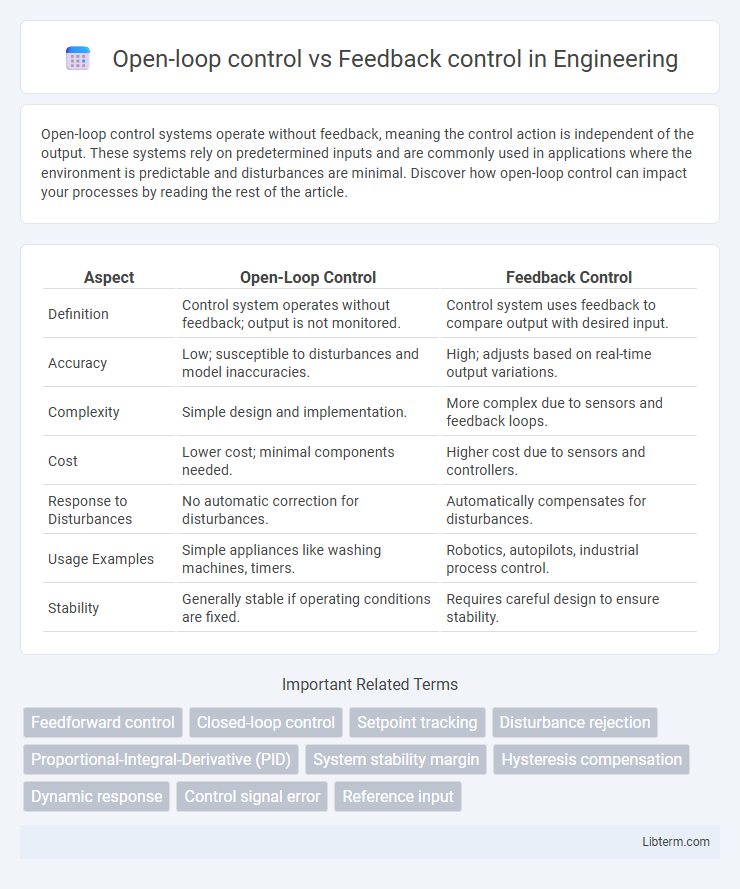Open-loop control systems operate without feedback, meaning the control action is independent of the output. These systems rely on predetermined inputs and are commonly used in applications where the environment is predictable and disturbances are minimal. Discover how open-loop control can impact your processes by reading the rest of the article.
Table of Comparison
| Aspect | Open-Loop Control | Feedback Control |
|---|---|---|
| Definition | Control system operates without feedback; output is not monitored. | Control system uses feedback to compare output with desired input. |
| Accuracy | Low; susceptible to disturbances and model inaccuracies. | High; adjusts based on real-time output variations. |
| Complexity | Simple design and implementation. | More complex due to sensors and feedback loops. |
| Cost | Lower cost; minimal components needed. | Higher cost due to sensors and controllers. |
| Response to Disturbances | No automatic correction for disturbances. | Automatically compensates for disturbances. |
| Usage Examples | Simple appliances like washing machines, timers. | Robotics, autopilots, industrial process control. |
| Stability | Generally stable if operating conditions are fixed. | Requires careful design to ensure stability. |
Introduction to Control Systems
Open-loop control systems operate without using feedback, relying solely on predefined inputs to execute actions, making them simpler but less accurate under varying conditions. Feedback control systems continuously monitor output variables and adjust inputs to maintain desired performance, enhancing precision and stability in dynamic environments. Understanding the fundamental differences between open-loop and feedback control is essential for designing effective control systems in engineering applications.
What is Open-Loop Control?
Open-loop control is a type of control system where the output is generated based on predefined inputs without using feedback to adjust performance. It operates solely on the initial set instructions, making it simple but less accurate when disturbances or changes occur in the system. Common applications include basic household appliances and simple industrial processes where precise regulation is not critical.
What is Feedback (Closed-Loop) Control?
Feedback (closed-loop) control continuously monitors system output and compares it to the desired input or setpoint, enabling automatic adjustments to minimize errors. This dynamic process enhances accuracy and stability by correcting deviations in real-time through sensors and controllers. It is widely used in industrial automation, robotics, and temperature regulation systems to maintain optimal performance under varying conditions.
Key Differences Between Open-Loop and Feedback Control
Open-loop control operates without monitoring system output, relying on predetermined inputs to achieve desired results, which can lead to inaccuracies if disturbances occur. Feedback control continuously measures output and adjusts inputs accordingly to maintain system stability and accuracy, compensating for external changes and internal variations. The key difference lies in feedback control's ability to self-correct by comparing actual output against desired performance, unlike open-loop systems that lack real-time error correction.
Advantages of Open-Loop Control
Open-loop control offers simplicity and cost-effectiveness by eliminating the need for sensors and feedback mechanisms, which reduces maintenance requirements and system complexity. It provides fast response times and predictable performance in environments where disturbances are minimal or well-characterized. The reliability of open-loop control makes it ideal for applications such as washing machines, irrigation systems, and basic temperature regulation where precise feedback is unnecessary.
Advantages of Feedback Control
Feedback control offers enhanced accuracy by continuously monitoring system output and making real-time adjustments, reducing errors caused by disturbances or model uncertainties. This control approach increases system stability and robustness, effectively compensating for changes in environmental conditions or system dynamics. Feedback mechanisms improve overall performance in complex applications such as robotics, aerospace, and process control by maintaining desired output despite variations.
Limitations of Open-Loop Control
Open-loop control systems lack the ability to correct errors during operation because they do not use feedback to monitor output performance, leading to inaccuracies in the presence of disturbances or system variations. This limitation makes open-loop control unsuitable for processes requiring high precision or adaptability, such as temperature regulation or chemical mixing in dynamic environments. Consequently, open-loop systems often suffer from reduced reliability and performance compared to feedback control systems that continuously adjust based on real-time data.
Limitations of Feedback Control
Feedback control systems often face limitations such as delays in response time, which can cause instability or oscillations in system performance. They rely heavily on accurate and timely sensor data; any noise or inaccuracies can degrade control quality and result in poor system behavior. Furthermore, feedback control may struggle with systems that have rapidly changing dynamics or when precise modeling is difficult, limiting its effectiveness in highly complex or nonlinear environments.
Common Applications of Each Control Method
Open-loop control systems are commonly used in applications such as washing machines, microwave ovens, and irrigation systems where preset commands execute without sensor feedback. Feedback control is essential in environments requiring precision and adjustment, including temperature regulation in HVAC systems, autopilot in aircraft, and industrial robotic arms. Both control methods optimize performance based on application demands, with feedback control providing dynamic correction and open-loop systems offering simplicity and cost-efficiency.
Choosing the Right Control System for Your Application
Open-loop control systems provide straightforward operation without feedback, suitable for applications with predictable and consistent environments where precision adjustments are unnecessary. Feedback control systems continuously monitor output and adjust inputs to maintain desired performance, ideal for processes needing high accuracy and adaptability to disturbances. Selecting the right control system depends on factors like system complexity, required precision, environmental variability, and cost constraints.
Open-loop control Infographic

 libterm.com
libterm.com